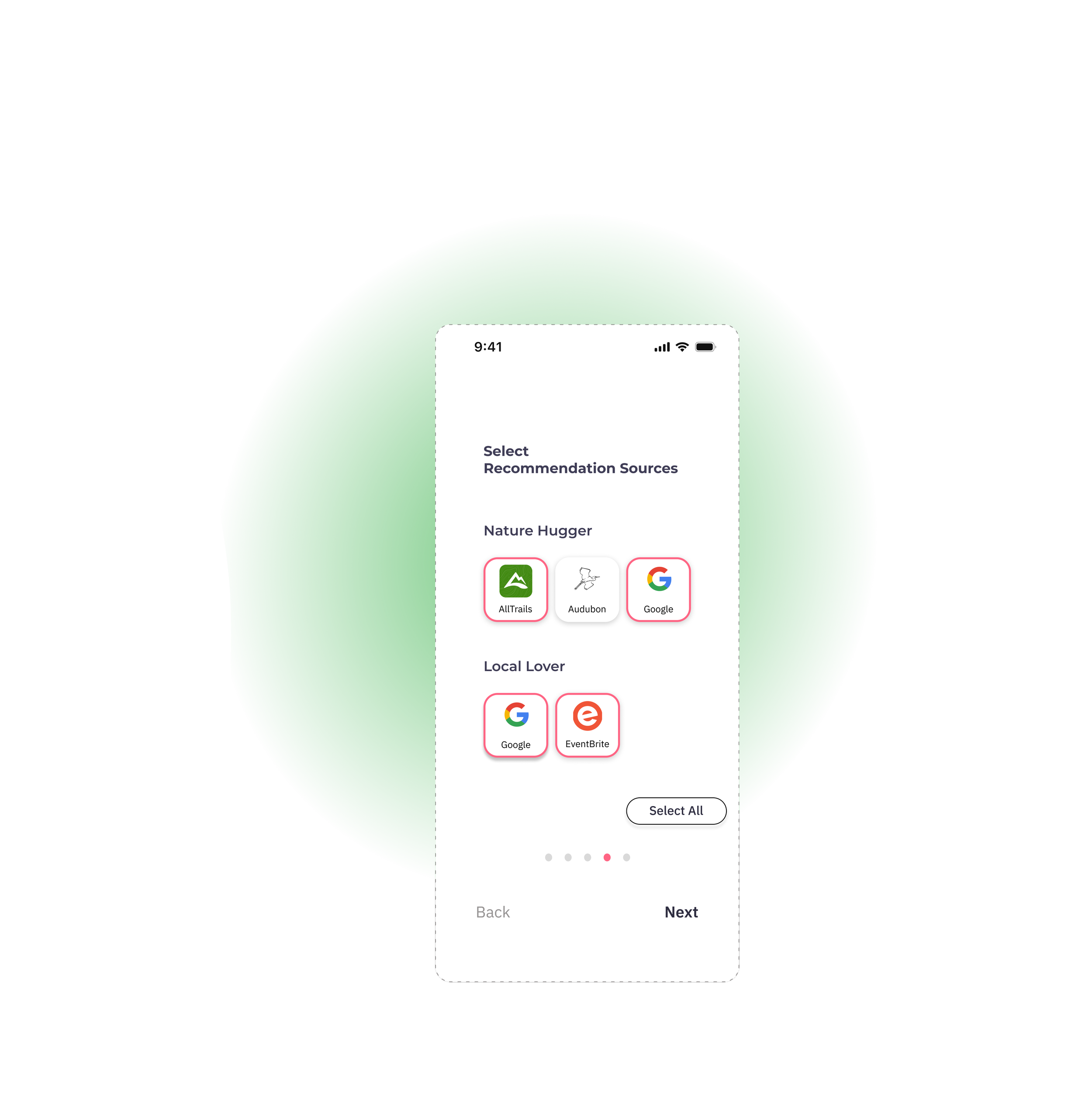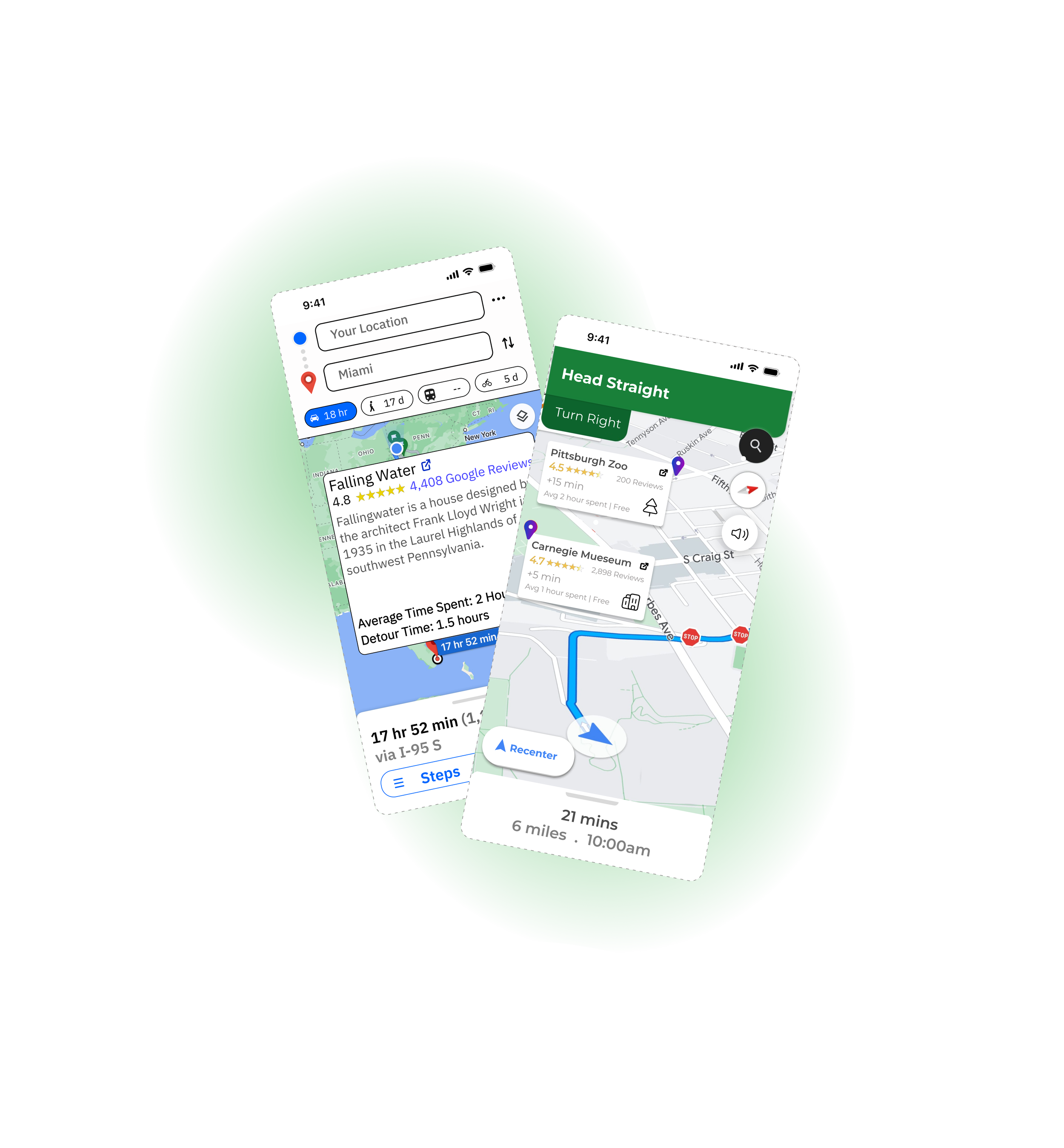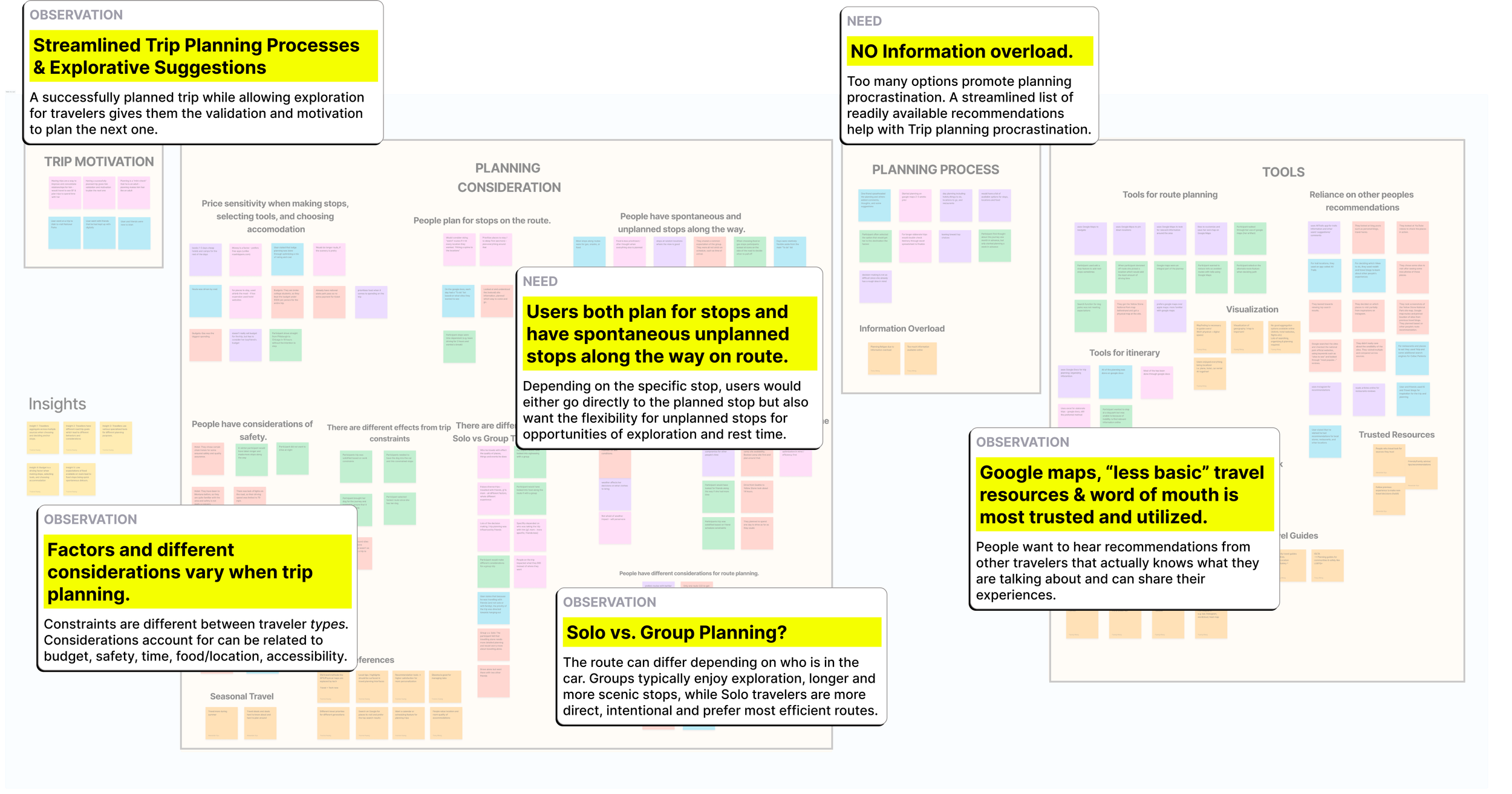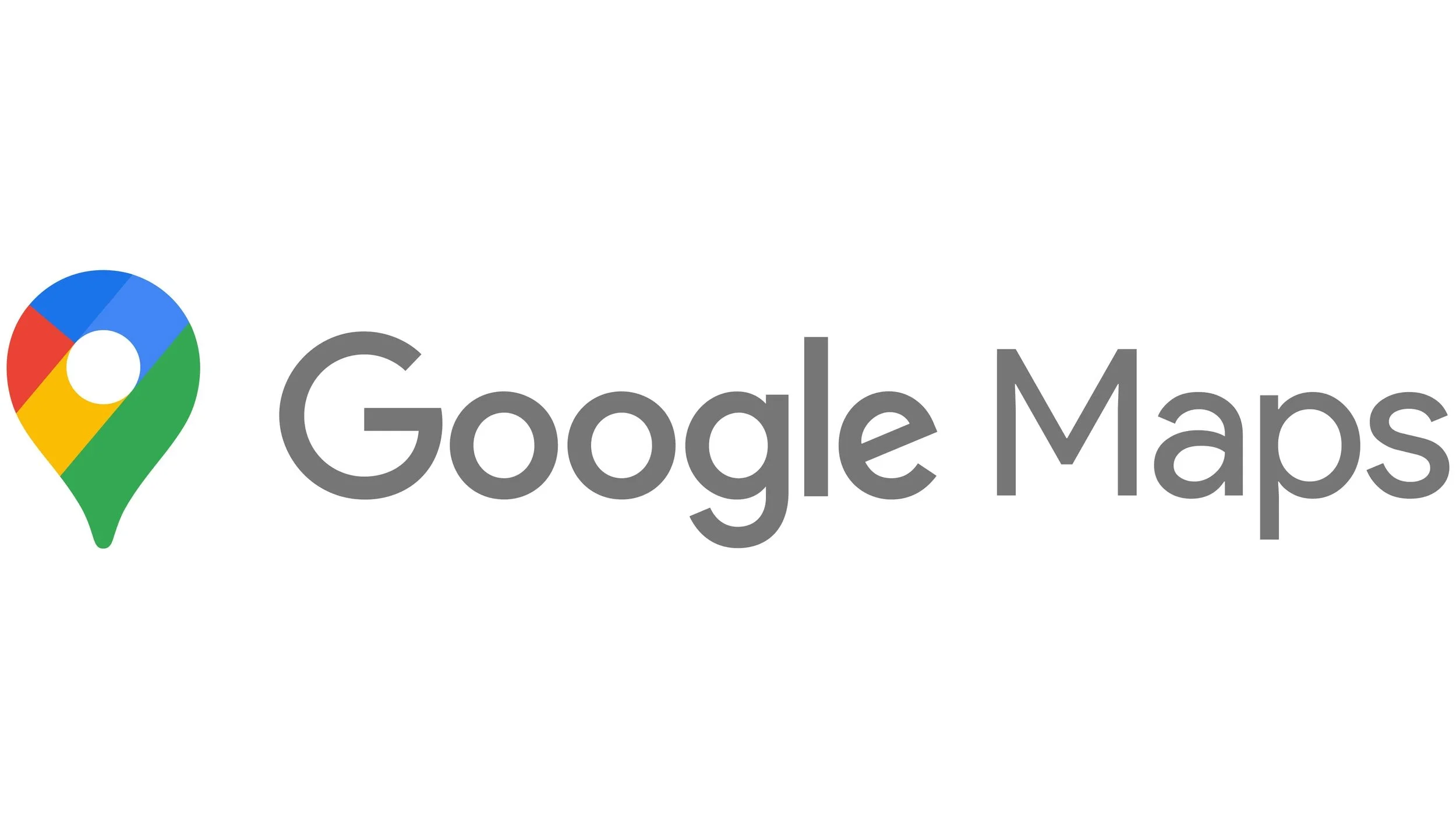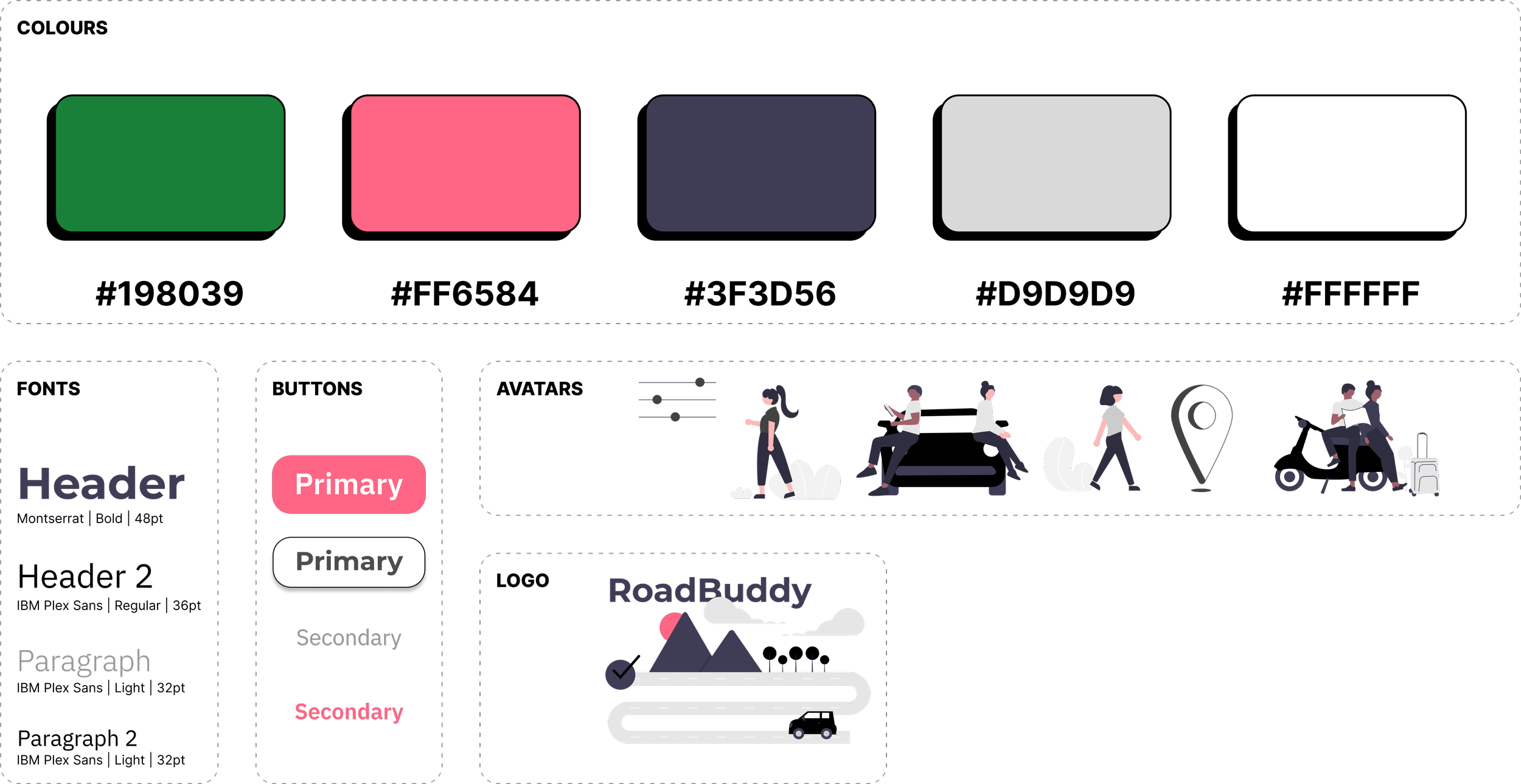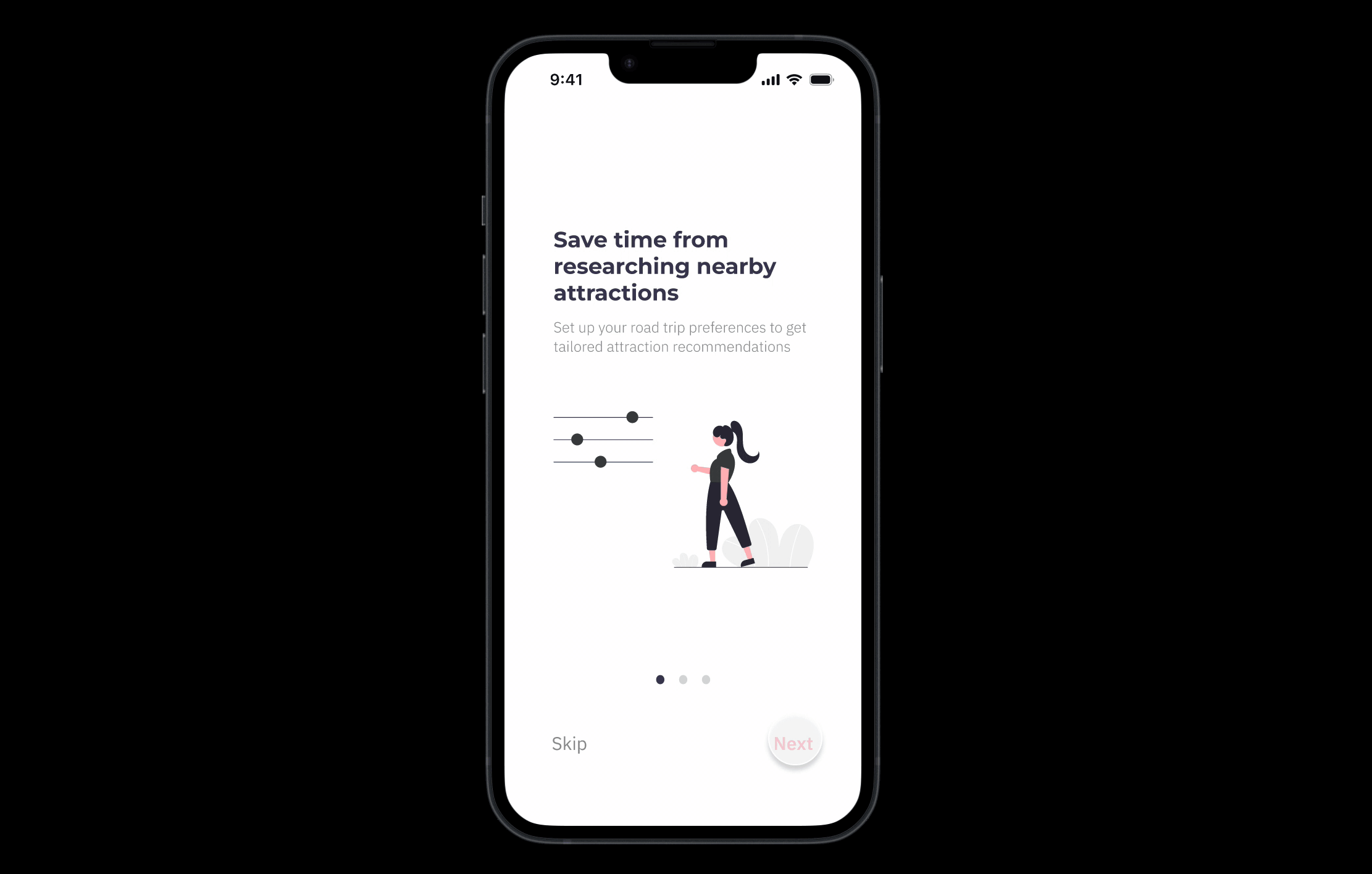RoadBuddy
Simplifying the pre-planning & on-the-go experiences for RoadTrippers!
Overview
Role & Team
I worked with Alex Kyu, Anahita Seghal, Diana Wang, Yvonne Huang for a 4 week project.
Goal
Create a new service that streamlines the trip planning process to increase user satisfaction.
What I did
User research & testing, UX/UI design, prototyping, team resolution, pitching.
What I delivered
User personas, customer journey maps, market research, sketches, wireframes, lo/mid/hi screens.
Your most intuitive & supportive pal on the roadtrip! 🚗💨
Streamlining research of nearby attractions, generates route options based on user preferences and notifies the user so there will never be a missed stop again!
Process

Problem
Travelers are always provided with the fastest route, rather than the most optimal.
We hypothesize from research that travelers plan their road trip routes based on different priorities and requirements or constraints. Additionally, typical online travel planning tools (e.g. Google travel and Trip Advisor), travelers are usually provided with the fastest path rather than given the opportunities to explore places on the way that best suit their needs.
“How might we help people optimize their travel route and stops depending on travel preferences when planning a road-trip?”
Solution
Real-time location based recommendations tailored to you!
💡Our project aim:
Create optimized travel experiences by providing route recommendations that satisfy travelers’ needs and preferences.
Quick & Informative On-Boarding Experience.
Hassle free registration
Brief overview & outline of app’s goals
Intuitive user graphics
Personalized character types
Understanding who they are traveling with
Traveling habits
Getting personal with the traveller.
Access to multiple recommendation sources.
Recommendations pulled from multiple sources.
Recommendations tailored to specific users.
Location tracking allows on-the-go recommendations
Intuitive, informative and condensed information about any location suggested
Get recommendations along the way.
Research
To get a generalized scope and understanding of current trip planning behaviors, patterns and resources. We started with some preliminary research through Think-Aloud studies, Story Telling, Data Analysis and general Competitor/ Stakeholder research. We started populating our findings to extract valuable insights.
Walk the Wall exercise for preliminary researchThere are a lot of existing factors we need to consider for roadtrip planning…
For easy organization and a wider scope, we split up the trip planning process by trying to understand trip motivation, planning considerations, planning processes and specific tools that are being used on the market.
Key Insights from Affinity Clustering Insight
Travelers aggregate across multiple sources when choosing or deciding anchor stops.
Insight
Travellers use various specialized tools for different planning purposes.
Insight
Important to differentiate between group & individual travel.
Insight
Low expectations of food available on route lead to food stops being quick spontaneous detours.
Insight
Travelers have different road trip goals which lead to different behaviors and considerations.
Insight
Budget is a driving factor when making stops, selecting tools, and choosing accommodation
Personas
We utilized our initial insights to determine targeted users. Additional user interviews are implemented to generate key personas.
Through many rounds of conducting interviews, Think-a-Louds, storyboarding and user testings, we got one step closer to finding out more insights and what is the best tool that can help specific frustrations and can cater to personalized filtering.
Throughout this project, we utilized these methodologies to ideate for target users. Conducting preliminary research, interviewing participants, infinity diagramming, and creating hypotheticals through storyboarding; this helped us infer user behaviors and major pain points.
Newbie Planner, Travels with dog (24F)
“I don’t like too many options… especially if they weren’t planned before. Too much information on the go stresses me out!”
Intermediate Planner, Car Owner (23M)
“When I try to add all the stops on my route it takes too long… I just want an app to fit a spline to the locations”
Novice Planner, Nature Lover (23M)
“If I only have limited hours to spare… I want a tool to help me plan fast! … this is like a mini-check on becoming an adult”
Group vs. Individual travelers have different behaviors, pain points and needs… this analysis allowed us to narrow down our scope.
When traveling in a group, there are many more considerations of different preferences, time constraints and restrictions. Additionally, group travel is usually associated with leisure and more flexibility. Therefore a route suggestion app may be more useful to this target group.
When traveling solo, typically there is already a direct route readily planned. Typically solo travelers have a rigid schedule and are less likely to detour or interested in exploring options outside their planned path. Therefore a route suggestion map may not be the most useful for this target group.
Most useful times for recommendations are during the trip and while the planned route is taken place.
After stepping in the 👞 of our target users, we are able to determine pains, gains and what kind of application would help them plan a successful road trip. Additionally, through understanding the user journey of pre-planning and going through the trip we can determine the areas of the journey that has most potential on utilizing the road recommendation tool.
Ideation
Based on the research and user generation we started exploring some “Crazy” ideas.
Based on the five opportunities found during the analysis phase, the team quickly generated possible scenarios with the Crazy 8’s activity. Following this, we conducted priority voting to determine the four most intriguing ideas and their corresponding user requirements.
A tool that notifies major missing stops while sorting out target recommendations to allow users to make evidence based decisions?
Based on those four most intriguing ideas, we did Storyboarding to expand the narrative for our application idea. We mainly focused on the ideas of: spontaneous detouring, route comparisons, fear of missing major stops and finding most useful of recommendations.
Have you ever needed recommendations from a certain type of person or group?
Have you ever suddenly wanted take a detour during a road trip but still wanted to loosely stick to your original plan?
Have you ever been on a road trip and wanted to make sure you didn’t miss any key stops?
Have you ever faced difficulty comparing different location options to find the best route for your road trip?
Feature
“Traveler Personalities”, allow users to pull from niche sources that most aligns.
Feature
“Alert system”, that notifies when major or recommended stops are approaching.
Feature
“Stops input”, input planned stops, we will generate route options based on preference.
Feature
Agility of recommendations, users can be as selective or flexible, to compare routes.
Design
Integration alongside Existing Map Applications with the addition of recommendation features.
We were challenged to determine to decide if this application can be stand-alone or be integrated with existing map applications. We knew that there was a lot of map applications out in the market and wanted to keep this feature as concise as possible. The more we researched the market, we realized that there was a need for more personalized recommendation and on-the-go alternative route options.
Lack of filtration for notifications. Information overload are distracting.
Lack of personalized and real-time recommendations for on-the-go.
Great recommendations but NO route or map generation options.
🔀 4 major flows:
Onboarding, Getting to know the User, Preferences and Map view.
We integrated features that allowed “Traveller Personality” types such as nature lover, art connoisseur, foodie, shoppaholic and adrenaline junkie. Research of specific trusted resources that cater to each personality type is also explored. Finally accessibility and frequency of notifications are discussed, users get to choose whether they should be notified depending on the type, number of ratings, time duration and proximity of each stop.
Creating an interactive color scheme while aligning to Google Map’s existing theme.
The color palette is kept quite simple, minimal and easy to read. I took a vibrant pink for selection purposes as it stands out and since this is meant to become a google maps plug in — the green is kept similar to that color palette. Additional avatars and graphics are used to help guide the users and provide adequate information.
Reducing information overload and distractions while being on the road.
This is an instantaneous route and stop recommendation application, the amount of content shown must be condensed — to prevent any distractions, confusion or stress while on the road. Through user testing and research, we had to determine what is the most important information shown to that will help dictate them to accept the stop.
Users found the flows understandable, informative and intuitive as a process. RoadBuddy wants to get to know you.
The boarding screen showcases the functionality and main goals with rapid screen visualizations. This allows users to catch a glimpse of what the app entails and hopefully pushes them to pursue more.
The user has personalized settings directed to their travel types or any other unique road trip situation. Types of resources can be filtered, users can trust personalized external sources. Notification preferences, allows them to have total control over any route alerts.
Let’s GET ON THE ROAD! 🚗💨 RoadBuddy will generate a personalized route with stop options based on user filters. As the trip commences, RoadBuddy will recommend location stops to allow the user to personalize and explore while on the go!
Reflection
⏭ Next Steps
How can this concept be integrated with more than road travel?
We originally decided on road travel due to its flexibility and the ability for traveler control. However, I wonder what this concept of route recommendations would look internationally? I want to explore how this would look like if this is done through planes, trains and other alternative ways of travel.
📚 Take Aways
Allowed me to test out multiple ways of research for my tool belt…
Since this project is very much research based, I learned multiple contextual methods and gained important skills that allowed me to explore all avenues of trip planning and know the users. I understand the importance of research collection and how this contributes to ideation. This gave me a very good basis on what experienced and well developed research looks like, I can now utilize all these methods for future UI UX research.











